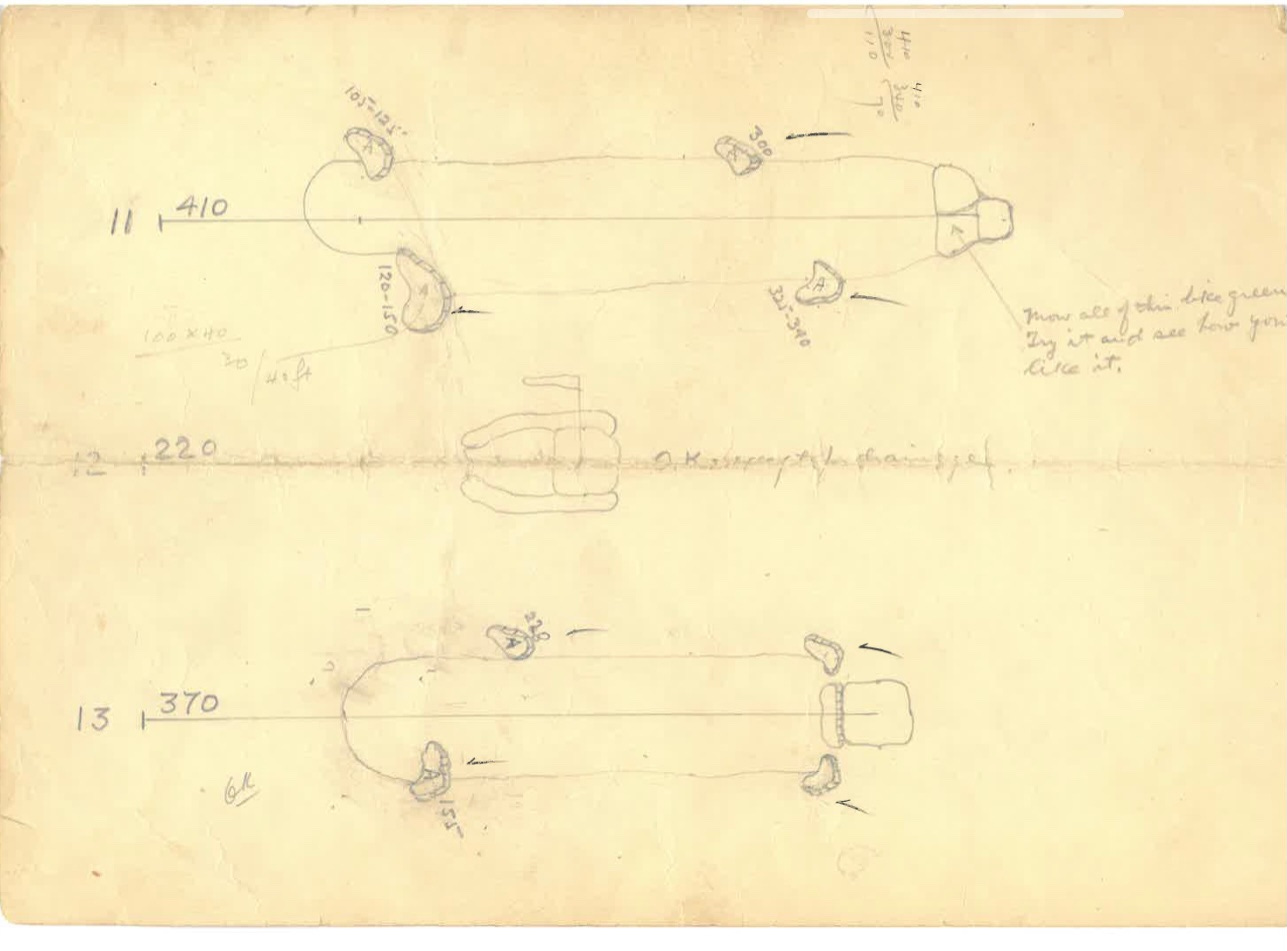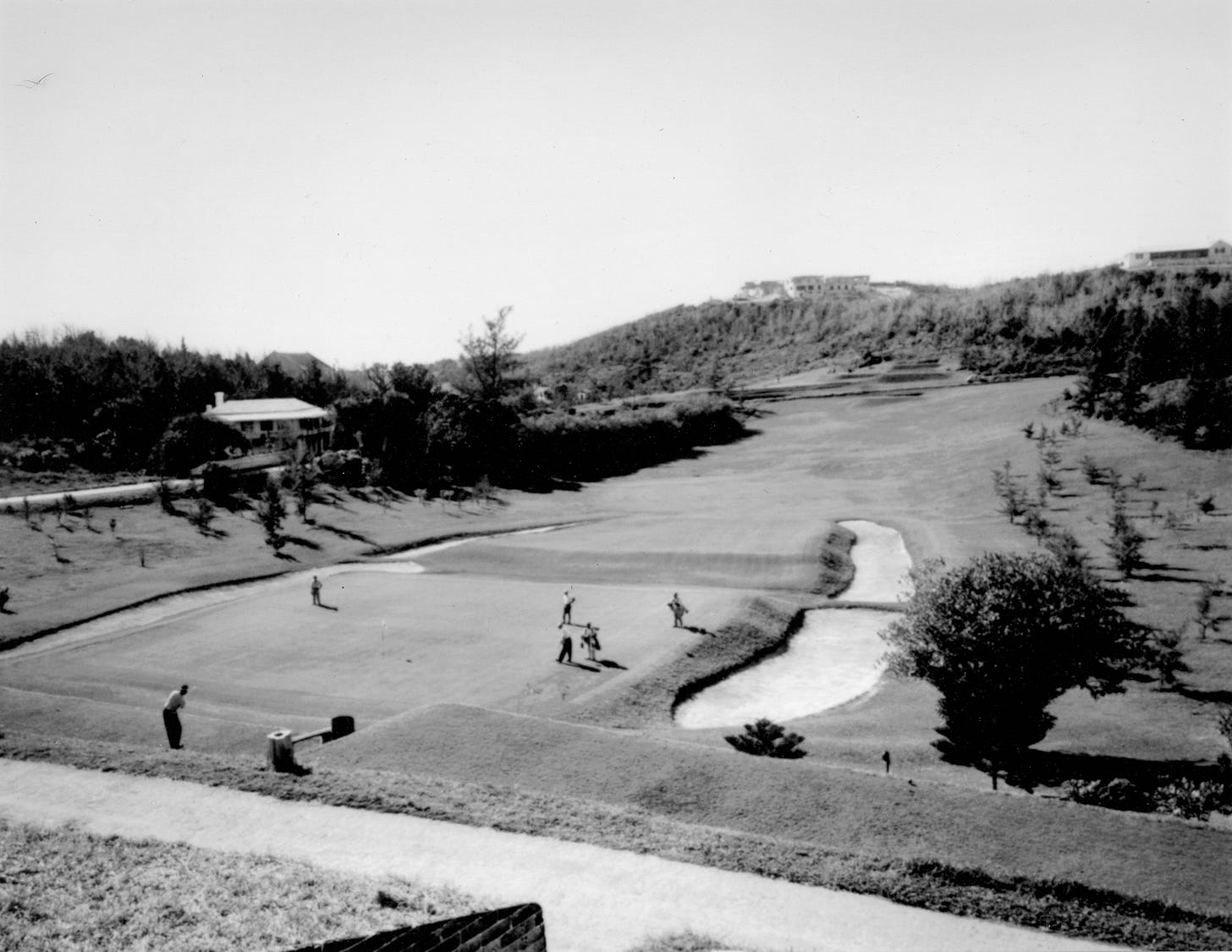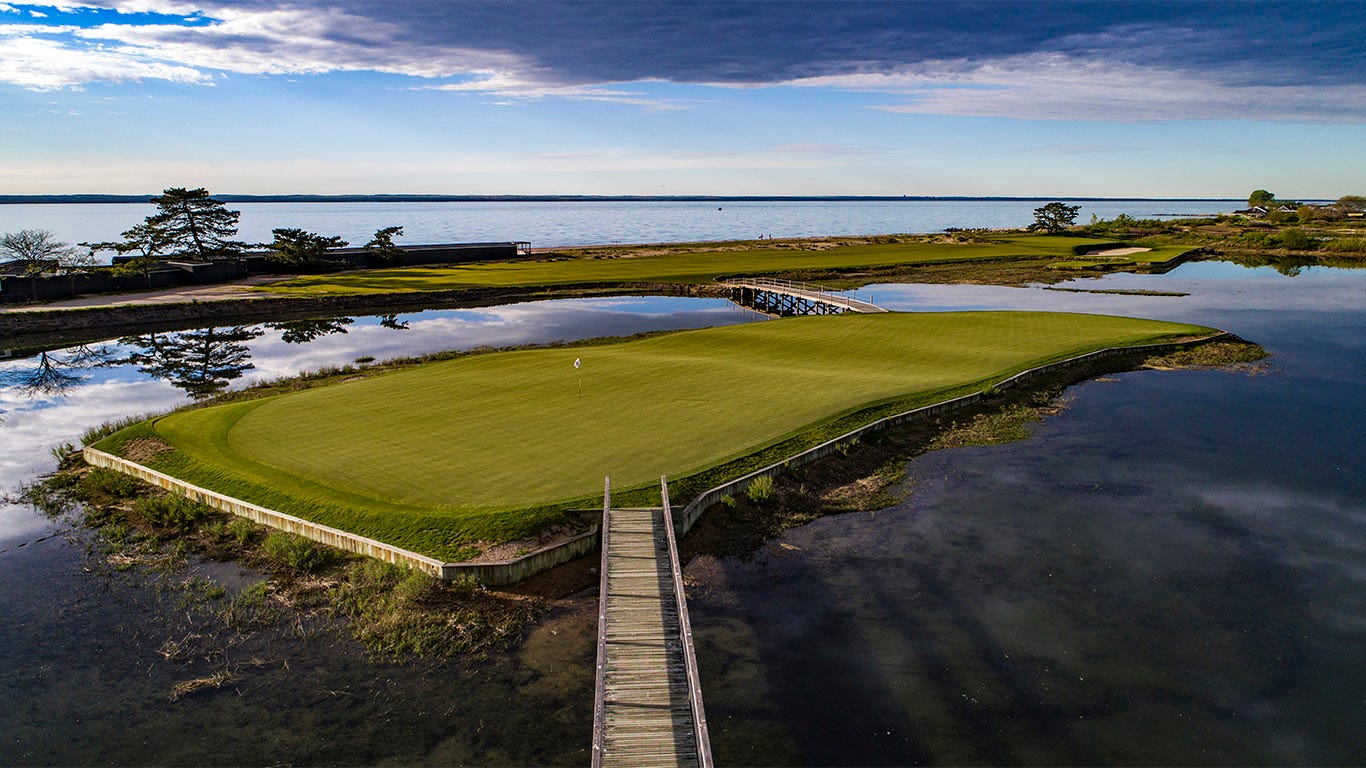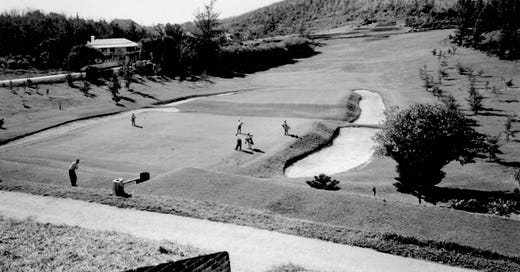One of the most unique template holes in golf is a styled double-plateaued, extremely long, slightly narrow hole, surrounded by left, right, and rear bunkers with a swale in the middle, originally dubbed “the Chasm.”
This refers to the famous Biarritz-style golf green. Originally designed by Willie Dunn Jr. at the Biarritz Golf Club in France, the first iteration of the hole was on the par-3 third. This hole, named for the golf course, became part of the template hole list for Charles Blair Macdonald and Seth Raynor—named "The Biarritz."
There are now two schools of thought regarding The Biarritz. One approach uses both the front and back plateaus of the green, allowing for front pin positions and utilizing the 5 to 6-foot deep swale as a hazard both long and short of the pin placements. The second approach places the green either right before the swale or immediately on the long side of it. This design incorporates the swale as a hazard for every pin position and elongates the hole, as only pin placements on the back plateau are available.

An article written in 1902 about backspin makes references to the par-3 third hole at Biarritz in France. It discusses the two plateaus and the necessity of carrying longer clubs over a 6-foot hazard. The article is unclear as to whether the front portion of the Biarritz-style green is fairway or green on the front plateau. The original designs for Biarritz Golf Club call for “The Chasm” hole to be measured at 90 yards. An all-green Biarritz-style green measures upwards of 40 yards, making front pins absurdly short, even by 1890s golf standards. This suggests that only the back plateau would have been available for pin locations, with the front plateau extending into the fairway.
The Biarritz Golf Club no longer exists, so we cannot verify these details in person. Other golf holes have been credited with the original Chasm/Biarritz design, including the 18th at St Andrews (called the Valley of Sin), the 12th hole at Biarritz Golf Club, and North Berwick’s 16th (called The Gate).
CBM and H.J. Whigham visited Biarritz (with Arnaud Massy) in early 1906 on their tour of great courses in preparation for the creation of NGLA. CBM mentioned what became known as his Biarritz concept shortly thereafter in a letter printed in a June 20, 1906, NY Sun article about his recent trip abroad:
"The best holes have not been found on the five British championship links alone... The idea for one hole comes from Biarritz. The hole in question is not a good one, but it revealed a fine and original principle that will be incorporated into my selection."
No mention is made of the famous Chasm. The description of the hole as "not very good" seems incongruous if he was referring to the famous Chasm. While CBM referred to the 12th hole, at that time, the Chasm hole at Biarritz was the 3rd hole and was only around 100 yards or less. Flipping the nines doesn’t work because of quirks in the layout. I have never read any description of the famous Chasm Hole that mentioned a hog’s-back, a swale, or the method of playing using the ground game. Therefore, as far as I can tell, the original Biarritz concept was based on a different hole at Biarritz, likely one down by the water in the Chambre d'Amore (the 12th hole on the map).
CBM expanded on this description later that year in his article on ideal holes in Outing Magazine, where he provided a sample listing of 18 holes:
“15. 210 yards. Suggested by the 12th Biarritz, making a sharp hog-back in the middle of the course. Stopping thirty yards from the hole, bunkered to the right of the green, and good low ground to the left of the plateau green."
Again, there is no mention of the famous Chasm. Rather, CBM described a "sharp hog-back" in the middle of the course, ending 30 yards short, with the green on a plateau and a large swale short of the green. H.J. Whigham echoed this understanding in 1913 when describing the inspiration for Piping Rock's Biarritz:
“There is a Biarritz hole of about 220 yards, which is new to this country and is one of the best one-shot holes in existence. There is a hog’s back extending to within thirty yards of the green and a dip between the hog’s back and the green."
Again, there is no mention of a Chasm, and nothing indicates they were referring to the Chasm Hole (which was quite famous and called "The Chasm") as opposed to a less noteworthy hole at Biarritz.

Regardless of its inspiration, the Biarritz Green is easily recognized in the modern game. Side-saddle bunkers encase a long green with a large swale. The modern game, however, has evolved the green’s composition.
From Peter Palacios at Yale Golf Course (Charles Banks, 1925):
"This hole has its original on the Biarritz course at the famous watering hole in France of the same name... There is a 163-yard carry from the back tee. The green proper is behind a deep trench in the approach. The approach is about the same size as the green itself and is bunkered heavily on both right and left, with water jutting in on the right front. The fairway is the lake. The green is heavily battered at the back and right, and the whole psychology of the hole is to let out to the limit. Correct play for this green is to carry to the near edge of the groove or trench and come up on the green with a roll. The disappearance and reappearance of the ball in the groove adds to the interest of the play."
Yale now has a front and back plateau turfed as a green. This was not its original design but offers a different challenge to a new type of golf. Play in 1925, when Banks was quoted, would have involved less height, less spin, more ground utilization, and more rolling shots. The modern game asks players to hit towering shots with spin to access tucked pins, making the front plateau ideal for another green pad and a shorter but tough pin placement.
Other courses have gone back and forth on their interpretation of the Biarritz Green. Mid Ocean Club now plays it as both fairway and green, though that was not always the case.
“At MOC, we currently have a green and a fairway, but we’ve had all green, most recently some time between 2016 and 2018. I’ve attached a photo of our Biarritz Green from the 1950s,” said Kace Wales, marketing coordinator at Mid Ocean Club.

Newer courses that have utilized the Biarritz Green have turfed and maintained them as all-green, most notably at Streamsong Red, where the front pin is treacherous. The 190-yard forced carry over water has little area to stop before reaching the deep swale. Just hitting the green is not enough for par, as anything in or through the swale to a front pin is likely to result in a three-putt.
In another example, we have a transitioned Biarritz Green. At Yale Golf Course, the green runs through the entirety of the plateaus and swale. At Blue Mound Golf and Country Club (considered a nearly untouched Raynor), the Biarritz has remained fairway and green, sticking to the original plans.
From Alex Beson-Crone, the Superintendent at Blue Mound Golf and Country Club:
“Raynor didn't exclusively use cinders (for drainage) on only greens pads, but at Blue Mound, he did. For example, during their most recent bunker renovation, Chicago found a cinder layer in the base of all their bunkers. I haven’t found cinders anywhere other than greens. I’ve cored all over the front and swale on 3, and there’s no cinders, but there definitely is on the current Biarritz greens pad. It’s one of the few greens we find cinders in the bottom of the cup cutter when we change cups."
The only green on Raynor’s original plan for the course (1924) was the back. Charles Banks made recommendations for mow lines and bunker placement during his site visit in 1927.
Yale and The Creek (Raynor and CBM) are among the few Biarritz greens that can claim authenticity while being all-green from front to back. The shared characteristic in the two is the forced carry to the front. At The Creek, the Biarritz is an island isolated in an off-ocean pond with two small footbridges connecting it to the turf. The green sits slightly diagonally from the tee and can measure out to 200 yards with a pin in the back of this formidable par-three.

“The back pin at Yale’s 9th measures the hole at 230 yards. To get to that back pin, the tee shot has to carry the lake (175 yards) and have enough juice to roll through the swale to the back pin. There’s nothing worse than hitting a great tee shot here that carries the lake but ends up in the swale in the middle of the green. Putting out of the swale is, at best, a roll of the dice. Four-putts out of the swale are a definite and unpleasant possibility. Any tee shot that finds the bunker requires precision, as any bunker shot could end up in the swale with all the attendant consequences. It’s a great hole that requires an excellent tee shot to a particular spot on the green. The swale must be avoided. I believe that putting out of the Biarritz swale is tougher than the Valley of Sin at the Old Course,” said Joseph Bronson, author of PARdon Me.
So, is a Biarritz over water fully green, and a Biarritz without a forced carry fairway and green? Not necessarily. At Westhampton, Greenbrier Old White, Fox Chapel, Southampton, Tamarack Country Club, and Mountain Lake, the hazard is absent, but the Biarritz remains all green. At Fishers Island, there is a forced carry to a half fairway, half green configuration.
Experts agree that the half-fairway, half-green Biarritz was the original design of the hole when not paired with a hazard. As the game continues to prioritize high, soft shots over low running ones, golf courses have adjusted their Biarritz to accommodate the modern style of play. In this writer’s opinion, the front pin on a Biarritz adds a level of thrill, as both long and short shots are met with significant penalty.




There is NO mystery. It’s a beautiful design